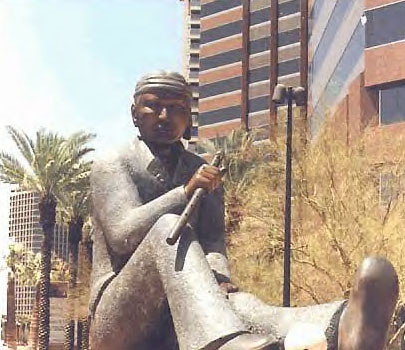|
|
Canku Ota |
|
|
(Many Paths) |
||
|
AN Online Newsletter Celebrating Native America |
||
|
February 24, 2001 - Issue 30 |
||
|
|
||
|
This Date In |
||
|
North American Indian History |
||
|
from On This Date in North American Indian History at http://americanindian.net |
||
| Feb. 24, 1831: | The CHOCTAW Dancing Rabbit Creek treaty is ratified, today, by the U.S.Senate. The CHOCTAWs will leave Mississippi for Indian Territory (Oklahoma). While many CHOCTAWs are opposed to the treaty, they lack organization. It will be publically proclaimed on May 26, 1831. |
| Feb. 25, 1875: | After the battle of Palo Duro Canyon, Lone Wolf, and his followers, head across the plains. But after a relentless search by the Army, on this date Lone Wolf, and 252 KIOWAs, finally surrendered at Fort Sill, in south-central Oklahoma. Lone Wolf would eventually be sent as a prisoner-of-war to Fort Marion, in St.Augustine, Florida. |
|
|
|
| Feb. 26, 1860: | The WIYOTs lived on the upper California coast between the Little River and the Bear River. An annual ceremony lasting over a week is held in the village of Tutulwat on an island in the river in what is now Eureka, California. By WIYOT tradition, everyone was welcome at the ceremony, including whites. Tonight after the ceremonies were finished, a group of men from Eureka snuck into the village and attacked the participants. Several other nearby villages were also attacked. An estimated 80 to 100 indians were killed in the sneak attack. An annual vigil is now held on a nearby island to commemorate the event. |
| Feb. 27, 1973: | The Wounded Knee occupation begins. The occupation has been designated a historic and cultural event that brought attention to Indian issues. It will last until May 8, 1973. |
| Feb. 28, 1877: | The Standing Rock SIOUX Reservation has been created by the Treaty of April 29, 1868 and an Act of Congress today in Dakota Territory. It will cover 4,176 square miles and be occupied by "BLACKFEET, HUNKPAPA, Lower and Upper TANKTONAI SIOUX." |
| Mar. 1, 1851: | Today, Governor McDougal, of California, will write to the President stating there are over 100,000 hostile Indians in California. He will inform the President that an uprising is going on. This information is false, and the Governor never specifies who's revolting or where the uprising are located. He requests permission to call out the militia as U.S. troops. |
| Mar. 2, 1989: | The NAVAJO Code Talker Monument is erected. |
|
Code Talker Monument |
|
| Mar. 3, 1871: | The House is unhappy because they are not involved in the treaty making process, only the Senate votes. They pass an Act whereby Indian nations will not be considered sovereign nations. The act reads that the Indians would not be "acknowledged or recognized as an independent nation, tribe or power with whom the United States may contract by treaty." |
| Mar. 4, 1930: | The Coolidge Dam is dedicated. It swamps Indian lands. |
|
Coolidge Dam |
|
| Mar. 5, 1831: | Today the Supreme Court decided the case of the CHEROKEE Nation v. Georgia. The court decided that the CHEROKEEs are not a "foreign state", and therefore the court has no jurisdiction in the dispute. However, the court does decide that the CHEROKEEs are a distinct political society capable of governing itself, and managing its own affairs. |
| Mar. 6, 1864: | After surrendering to the Army at Forts Canby and Wingate, on the New Mexico-Arizona line, the first group of NAVAJOs set out, on this date, to the Bosque Redondo Reservation. Over 1400 would make this first trip with several dying while on the trail. |
| Mar. 7, 1960: | New York State wishes to build a dam which will flood lands belonging to the TUSCARORAs (1 of the 6 IROQUOIS Nations). The Indians take to issue to court as a violation of the treaty of 1794. After winning several lower court decisions, the Supreme Court, today, issues a 6-to-3 decision against the TUSCARORAs. In the dissenting opinion, Justice Hugo Black says, "I regret that this court is the agency that breaks faith with this dependent people. Great nations, like great men, should keep their word." |
|
|
|
| Mar. 8, 1837: | By today, almost 4000 CREEKs are assembled near Montgomery, Alabama, in preparations for them to be removed to Indian Territory. Most of these are family members of the CREEKs fighting for the government against the SEMINOLEs in Florida. The government had promised to protect them in Alabama until the CREEK soldiers returned. The government would not live up to this promise. |
| Mar. 9, 1935: | Officers of tribes are now considered U.S. Officers |




